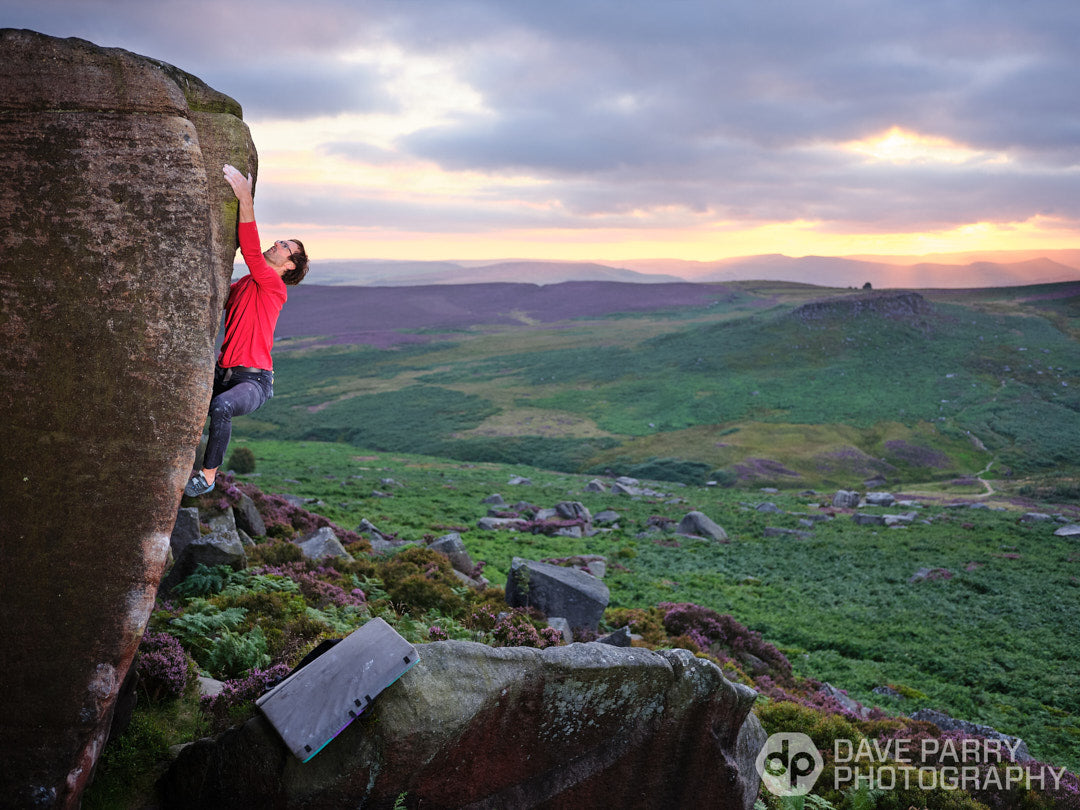Photographer Dave Parry captures the North of Englands climbing culture.
Grit Blocs by Dave Parry showcases 100 of the finest must-do boulder problems on the gritstone outcrops, edges and quarries of the Pennines. The stunning photography is accompanied by texts that expand on the context and characteristics of the boulder problems. It’s a book to inspire all climbers, from the beginner to the seasoned pro. We have invited Dave to tell us a bit more about the book and his work for this guest blog post.

The book has been described as “a love letter to climbing in the North”, and that’s not far from the truth. As a South Yorkshire native, born and bred, I have a strong personal connection to the Pennines. From the Peak right up to Northumberland, it’s where I first started walking and hiking as a kid, and since starting climbing on the crags local to Sheffield twenty five years ago I’ve not stopped since. We’re blessed with all the climbing we have in the Pennines, and within easy access of Sheffield in particular. But with that comes a responsibility to look after it. As new climbing walls in cities open up and new climbers are attracted to climb outside it’s critical we don’t just all go to the same old places and wear them out.

So part of the idea of the book was to spread the load a little, to act as a shop window for some of the less well known venues and encourage people to explore off the beaten track a little bit more.
About 25% of the shots in the book are from guest photographers who’ve supported the project, easing the logistical burden on me a little, and in some case provided amazing photos of historical importance. My own images in Grit Blocs are a combination of the old and the new. There are photos from my archive stretching back over 15 years or so, and images shot specifically for the book over the autumn and winter of 2021/22.

As such there’s a real mix of formats and cameras in there, right back to my first Nikon D70, 35mm slide film, various medium formats, Micro 4/3rds, Xpan, Fuji X system, with the recent shoots being with the superb Fuji GFX system accompanied by the X100F. There’s even some 5x4” large format shots in there.
When I look back on the way my work has evolved it’s apparent that the years I spent heavily immersed in large format landscape work had an impact on my approach to composition and the overall feel I was often trying to invoke in a lot of the book images. All the time spent loitering around the Peak pre-dawn or at dusk trying to finesse a composition upside down on the camera’s ground glass back, juggling all the elements in a scene with just a couple of prime lenses and the camera’s position at my disposal, has sharpened my instincts for achieving a sort of balance and gravitas within the composition. It’s one of the parts of photography there’s no automation or technological shortcuts for; you just have to put the hours in.

So in the book I’ve tried to bring that sensitivity for composition to the forefront where possible, and shy away from some of the perceived norms in climbing photography. So there’s not much of the super-wide-lens-shovedright-into-the-climbers-face type of thing. I’ve aimed for a little more restraint, to produce images that the reader can live with and revisit time and time again, rather than just shoot something that grabs the eye when scrolling down Instagram but is then just as quickly forgotten.
Similarly, flash use in climbing photography and outdoor action in general can be a bit divisive - it’s too easy to use as a gimmick, a stylistic crutch, which maybe has a ‘wow’ effect initially but the viewer soon becomes a bit alienated by it. I actually use flash outdoors more than most, but I’m not really trying to shoot for fast Instagram likes so my aim with the book shoots was to balance flash with ambient sensitively, not to let it dominate, and ideally let the subject matter sing and perhaps accent the shape of the rock or the climber.

Having said that, there is one particular shot in the book with the flash blatantly in shot, which is not my normal approach, but this was a case of the Peak Districts most famous natural phenomenon - the dreaded midges - getting the better of us. I had perched the flash down on a rock and I took a few test shots while my friend John was climbing, just as a starting point to see how the angle looked and what was and wasn’t in shot. But then we were both overcome by a sort of midge-induced panic, so we legged it sharpish. The wind and dropped and there was no way we were standing still for another second, already scratching at our bare arms and frantically waving our hands around. As luck would have it when I later checked the test shots I actually like the effect of the sunstars around the flash so I decided to let that one go - a welcome silver lining to being eaten to death high on the moors.
You can puchase a copy of Grit Blocs through the publishers website.



































